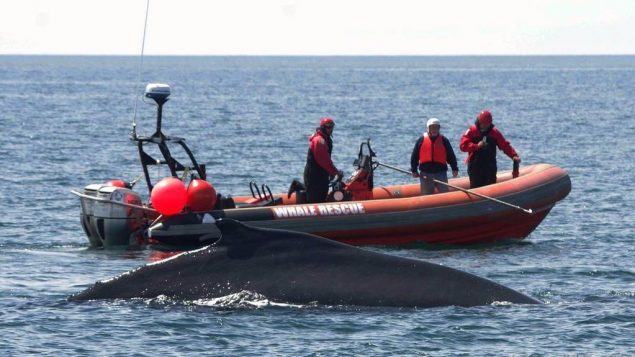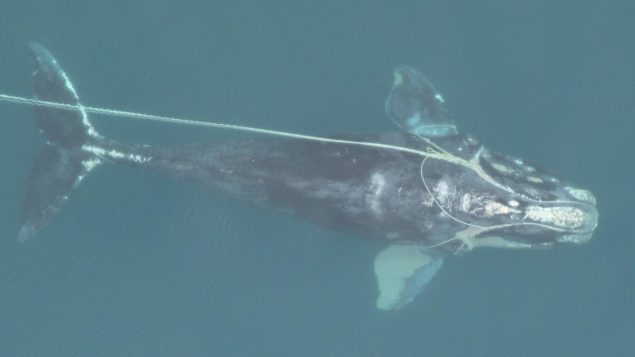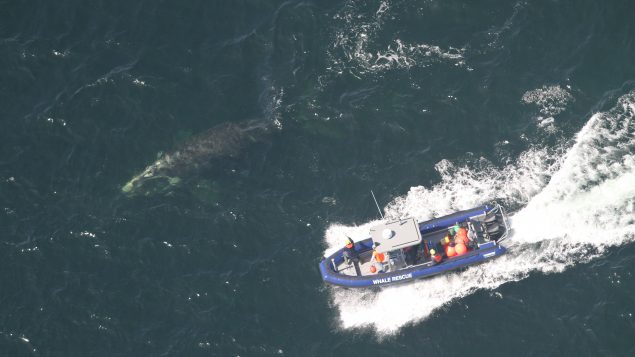A Canadian whale rescue team managed Thursday to partially free one of three entangled North Atlantic right whales spotted by aerial surveillance in the Gulf of St. Lawrence this week.
The Department of Fisheries and Oceans (DFO) said right whale No. 4423, a five-year-old male, was spotted around 10 a.m. local time on Thursday during an aerial surveillance flight by the U.S. National Oceanic and Atmospheric Administration (NOAA).
The Campobello Whale Rescue team from New Brunswick removed fishing gear that kept the whale from using its tail when diving, said a statement by the DFO.

Members of the Campobello Whale Rescue Team in action in July 2018. (Submitted by Neil Green)
Moira Brown of the Canadian Whale Institute said the rescue team was able to cut the line that trailed behind and below the whale that they thought was towing a heavy weight.
“The whale appeared to be able to swim more freely after the line was cut,” Brown told Radio Canada International in an email. “Some rope still remains through the whale’s mouth, but efforts were ended when the weather deteriorated late in the day.”
The weather was not suitable for another attempt on Friday, Brown added.
The whale rescue team received air support from NOAA and DFO’s Conservation and Protection airplanes, on-water support from fishery officers, as well as a research vessel from the New England Aquarium, DFO said.
There are currently 3 entangled North Atlantic #RightWhales in the Gulf of St. Lawrence. Surveillance is underway to monitor them, and we’re working with our response partners to see if disentanglement is possible. pic.twitter.com/krSf6gUKFI
— Fisheries and Oceans (@FishOceansCAN) 5 July 2019
Whale 4423 was first spotted entangled on July 4, 2019 east of Miscou Island, NB. Officials believe the animal was entangled prior to entering Canadian waters. Initial reports indicate it could be a whale first sighted entangled in Apr. 2019, in U.S. waters, DFO said.
Canadian and U.S. air crews continue to search for the two others entangled right whales that were recently observed in the Gulf of St. Lawrence.
Whale 4440 has been spotted several times since it was initially sighted entangled on June 29, but a disentanglement operation has not been possible, officials said.
The third entangled whale was first spotted on July 4, 2019 by a Transport Canada surveillance flight east of the Gaspé Peninsula, Quebec. This individual whale has not yet been identified, officials said.
“Locating these three whales is a challenging task,” DFO said. “Right whales spend a significant amount of time under water, making it difficult to observe them from the air.”
Search operations will continue, weather permitting, the statement said.

An emaciated, entangled North Atlantic right whale swimming with fishing trap rope around both flippers, through its mouth, and dragging behind it. The whale died one month later from emaciation and ultimately shark-inflicted wounds. (Florida Fish and Wildlife Commission, NOAA Permit #594-1759)
On July 8, the federal government announced additional measures to protect North Atlantic right whales.
The additional fisheries management measures include increasing the application of closures to fixed gear fisheries when a single whale is seen anywhere in the Gulf of St. Lawrence, increasing aerial surveillance, and moving forward with funding for initiatives to enhance marine mammal response, federal officials said.
Transport Canada will also expand the current slowdown zone in shipping lanes north and south of Anticosti Island where vessels are required to slow to 10 knots, and further east when a North Atlantic right whale is spotted in that area.
A slowdown buffer zone will also be expanded from 2.5 nautical miles to five nautical miles to trigger speed restrictions if a North Atlantic right whale is spotted in that area.
The application of mandatory speed restrictions will be expanded to any vessel measuring more than 13 metres long. Previously, it applied only to vessels 20 metres or longer.
Since June, officials have reported six deaths of right whales, including four breeding age females, in Canadian waters. Necropsies performed on the carcasses of these whales confirmed the cause of death for three whales as blunt force trauma consistent with ship strikes.
There are only about 400 North Atlantic right whales left and with fewer than 100 reproductive females the death of any right whale causes huge concern.
With files from CBC News







For reasons beyond our control, and for an undetermined period of time, our comment section is now closed. However, our social networks remain open to your contributions.